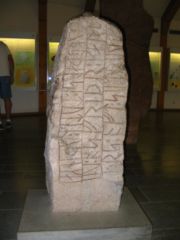
Sigtrygg Runestones
Encyclopedia

Rundata
The Scandinavian Runic-text Data Base is a project involving the creation and maintenance of a database of runic inscriptions. The project's goal is to comprehensively catalog runestones in a machine-readable way for future research...
catalog, are two of the Hedeby stones
Hedeby stones
The Hedeby stones are four runestones from the 10th century found at the town of Hedeby in northern Germany. This area was part of Denmark during the Viking Age.-Stone of Eric:...
that were found in Schleswig-Holstein
Schleswig-Holstein
Schleswig-Holstein is the northernmost of the sixteen states of Germany, comprising most of the historical duchy of Holstein and the southern part of the former Duchy of Schleswig...
, Germany
Germany
Germany , officially the Federal Republic of Germany , is a federal parliamentary republic in Europe. The country consists of 16 states while the capital and largest city is Berlin. Germany covers an area of 357,021 km2 and has a largely temperate seasonal climate...
, which during the Viking Age
Viking Age
Viking Age is the term for the period in European history, especially Northern European and Scandinavian history, spanning the late 8th to 11th centuries. Scandinavian Vikings explored Europe by its oceans and rivers through trade and warfare. The Vikings also reached Iceland, Greenland,...
was part of Denmark
Denmark
Denmark is a Scandinavian country in Northern Europe. The countries of Denmark and Greenland, as well as the Faroe Islands, constitute the Kingdom of Denmark . It is the southernmost of the Nordic countries, southwest of Sweden and south of Norway, and bordered to the south by Germany. Denmark...
. The runestones were raised after the Danish king Sigtrygg Gnupasson
Sigtrygg Gnupasson
Sigtrygg Gnupasson was a king of Denmark of the Swedish House of Olaf who ruled in the 10th century, according to Adam of Bremen and Sweyn II of Denmark....
by his mother Ásfriðr. Together with the account of Adam of Bremen
Adam of Bremen
Adam of Bremen was a German medieval chronicler. He lived and worked in the second half of the eleventh century. He is most famous for his chronicle Gesta Hammaburgensis Ecclesiae Pontificum .-Background:Little is known of his life other than hints from his own chronicles...
, the two inscriptions constitute evidence for the House of Olaf
House of Olaf
The House of Olaf was a dynasty which ruled Denmark in the late 9th century and early 10th century.*Olof the Brash*Gyrd and Gnupa*Sigtrygg GnupassonThe existence of Gnupa and Sigtrygg is confirmed by the two Sigtrygg Runestones....
on the Danish throne.
The stones are dated as being carved after 934 C.E. as the historian Widukind of Corvey
Widukind of Corvey
Widukind of Corvey was a Saxon historical chronicler, named after the Saxon duke and national hero Widukind who had battled Charlemagne. Widukind the chronicler was born in 925 and died after 973 at the Benedictine abbey of Corvey in East Westphalia...
recorded that King Gnupa
Gyrd and Gnupa
Gyrd and Gnupa were kings of Denmark in the 10th century according to Sweyn II of Denmark and Adam of Bremen. They were the sons of the Swedish chieftain Olof the Brash who had conquered Denmark and they ruled together according to Swedish tradition.Gnupa is mentioned on the two Sigtrygg...
, who is mentioned in both inscriptions, was forced to pay a tribute to the German king in that year.
DR 2
DR 2 was found at Haddeby in Schleswig-Holstein in 1797. At one time, scholars considered the word and rune selection on this runestone, when compared with the inscription on DR 4, along with other inscriptions as evidence of Swedish influence in Denmark during the 10th century. For example, although both DR 2 and DR 4 use the Younger FutharkYounger Futhark
The Younger Futhark, also called Scandinavian runes, is a runic alphabet, a reduced form of the Elder Futhark, consisting of only 16 characters, in use from ca. 800 CE...
, DR 2 uses "short twig" style runes for the n- and a-runes. However, in recent years this has been downplayed after it was shown that part of the evidence was actually due to a misdating of another runestone and the possible misspellings of some words in the inscriptions.
Transliteration of the runes into Latin characters
- A osfriþr : karþi : kum bl ' þaun oft : siktriku :
- B sun (:) (s)in : oui : knubu
Transcription into Old Norse
- A Asfriþr gærþi kumbl þøn æft Sigtryg,
- B sun sin ok Gnupu.
Translation in English
- A Ásfriðr made the memorial after Sigtrygg
- B her son together with Gnupa
DR 4
DR 4 was discovered in 1887 on the ramports of Gottorf Castle. Prior to the recognition of the historical significance of runestones, they were often used as construction materials for roads, walls, and buildings.Transliteration of the runes into Latin characters
- A osfriþr ÷ karþi kubl ÷ þausi ÷ tutiR ÷ uþinkaurs ÷ oft ÷ siktriuk ÷ kunuk ÷
- B ÷ sun ÷ sin ÷ ÷ auk ÷ knubu ÷
- C kurmR (÷) raist (÷) run(a)(R) (÷)
Transcription into Old Norse
- A Asfriþr gærþi kumbl þøsi, dottiR Oþinkors, æft Sigtryg kunung,
- B sun sin ok Gnupu.
- C GormR rest runaR.
Translation in English
- A Ásfriðr made the memorial, the daughter of Odinkar, after King Sigtrygg,
- B her son together with Gnupa.
- C Gorm made the runes.

